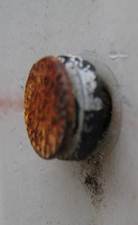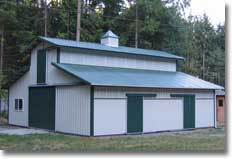NOTE: Today’s blog is part III of a 3 part series – back up two days for the beginning! For those who wish to skip parts I and II, a simple typographical error on the Internet got me to “hansonsteel.com” (Hanson versus Hansen-which is the company I work for) where I found an interesting page on “Steel vs. Pole Buildings”.
For sake of ease of reading, words in italics are those from the all steel building website.
Maintenance
Once your Hanson Steel Building is constructed, it is constructed for a lifetime; the buildings are virtually maintenance free for years.
Pole barns/buildings must have sheeting reattached on a regular basis. And wooden frames for doors and windows will need replacing. Sagging trusses or warped wood framing will cause steel to pull away from the screw connections thus generating water leaks. The leaks in-turn damage the wood construction further. Most pole barns/buildings will need a complete overhaul of sheeting, bolts and screws.
 In my thirty plus years, pole building sheeting has never had to be reattached. If proper screws (like those designed for diaphragm design) are used, the manufacturer guarantees the screws will outlast the steel roofing and siding. Companies using nails to attach steel to wood framing – yes, they will come out of the wood creating water leaks and damaging the wood framing. Using screws and the “right” screws as mentioned, stay tight over time due to their design, with the neoprene washer, do not allow water to enter.
In my thirty plus years, pole building sheeting has never had to be reattached. If proper screws (like those designed for diaphragm design) are used, the manufacturer guarantees the screws will outlast the steel roofing and siding. Companies using nails to attach steel to wood framing – yes, they will come out of the wood creating water leaks and damaging the wood framing. Using screws and the “right” screws as mentioned, stay tight over time due to their design, with the neoprene washer, do not allow water to enter.
I’ve been in all steel buildings which leak. All steel buildings are often used for commercial & retail uses. My wife and I frequent a ShopKo in Sisseton, SD. It had numerous leaks in the roof within 5 years of its construction. The most frequent causes of leaks…in either all steel or wood framed buildings are: use of improper screws, inadequately installed screws, or screws missing the framework. This retail building had customers walking around plastic covering damaged floor stock due to a leaking roof. I saw huge dollar signs in looking at the ShopKo building for repairs, not to mention damaged valuable merchandise. As a customer, it made me a bit leery to even be IN the building, wondering if the roof was going to come down as I watched it dripping into the many “catch” buckets.
The use of vinyl windows and steel jambed commercial steel entry doors eliminates the need for replacement. Prefabricated metal connector plated wood trusses will not sag, and once dried wood framing has been properly installed and fastened in place, warping is not going to occur. Again, I would like to see documentation of ANY pole barn needing a complete overhaul of sheeting, bolts and screws.
Roof and Wall Panels
All Hansen Steel Buildings offer 26-gauge roof and wall panels with strength of 80,000 psi.
Pole buildings are normally produced with a thinner roof and wall panel consisting of 29-gauge steel.
To give a perspective on steel thickness differences, from 29 gauge to 26 gauge the difference in thickness is .0045 of an inch. A sheet of 20# paper measures .0038 of an inch. Roughly speaking the difference between the two gauges is about the thickness of a piece of paper!
Now the important part – how much load will a steel panel carry? The “weak link” in a pole building structure is not the steel roofing and siding, it will be found somewhere in the underlying framing system. Taking a look at the span tables provided to us by American Building Components (ABC) for their Imperial Rib® (Imperial Rib is a registered trademark of ABC) panel, when placed across three equal spans of 24 inches, 29 gauge will support a live load of 124 pounds per square foot (psf) and 26 gauge 141 psf. The difference is only 13.7%!
Bottom line is… do you need 26 gauge steel? No, you really don’t. 29 gauge is going to do everything you need it to do. When would you need 26 gauge steel? If you are going to purchase an all steel building and have 5 feet between your purlins and 7 feet between your girts. On a wood framed building with half those spacings or less, it’s just overkill. Beware of those who try to sell you something you don’t really need.
Read more about steel thickness here: https://www.hansenpolebuildings.com/blog/2012/01/steel-thickness/
Fire Rating
Pre-engineered steel buildings offer a Class C fire rating which is the same as masonry buildings. Hanson Steel Buildings are designed for heavy wind, snow, rain or earthquake commercial building codes and provide protection for the building contents.
Wooden pole buildings offer a Class A fire rating which is the lowest resistance to fire hazard. Wooden pole construction cannot be used in many areas where there are stringent building codes for wind, snow, rain, or earthquake.
According to Stephen L. Quarles, Senior Scientist, Insurance Institute for Business & Home Safety, Richburg, SC, “A combustible material will be rated as Class A, Class B, or Class C based on its performance in this test. A material rated as Class A would have a lower flame spread, and therefore a better performance rating, than a Class C material.”
Pole buildings are Code conforming structures and can be designed to meet heavy wind, snow, rain and earthquake design loads. We’ve had clients get permits and successfully construct pole buildings at high snow ski-resorts, in California, Miami/Dade (most extreme wind), New York, Alaska and Hawaii. In fact, we have pole buildings in all 50 states, including very urban areas. As long as buildings are built to Code, there is no reason anyone should not be able to use post frame construction for their new building.
 Call them “red iron”, “bolt up” or Pre-Engineered Metal Buildings (PEMB) or a variety of other names and they are great buildings. Where they especially shine is where roofs clear span over 80 feet and where very low slope roofs are desirable (typically less than 3:12). And no, I did not hit my head and you did not wake up in a different space-time continuum.
Call them “red iron”, “bolt up” or Pre-Engineered Metal Buildings (PEMB) or a variety of other names and they are great buildings. Where they especially shine is where roofs clear span over 80 feet and where very low slope roofs are desirable (typically less than 3:12). And no, I did not hit my head and you did not wake up in a different space-time continuum.






